Saaj (Musical Instruments)
Saaj is a Punjabi word commonly used to refer to musical Instruments. Some of the instruments are decorated with ivory, silver, gold and peacock-feathers. Musical instruments are made by skilled craftsmen who have knowledge of musical sounds. The important towns where these instruments are manufactured are Lucknow, Rampur, Madras, and Tanjore.
Sikh 'music' or 'Shabad kirtan' is Kirtan-style singing of hymns or Shabads from the Guru Granth Sahib.
History
It began in the 16th century as the musical expression of mystical poetry conceived by the founder of Sikhism, Sri Guru Nanak Sahib Ji. Following him, all the Sikh Gurus sang in the then-prevalent classical and folk music styles, accompanied by stringed and percussion instruments. The style was where the text was of prime significance and the music played a supporting, albeit important, role. The Gurus specified the raag in which they sang each hymn in the Sikh sacred scripture, the Guru Granth Sahib. Several raag variants are unique to Sikh tradition.
While hindustani music underwent significant changes in the setting of mughal courts, and a separate stream of carnatic music developed in southern India, Sikh music retained its original form and styles, a unique musical tradition encompassing a variety of melodic forms and a well-developed percussive system.
In the 20th century the classical style was largely replaced by contemporary popular genres often based on Indian film music. Within the remaining classical tradition, the devotional Gurmat Sangeet style was overtaken by the darbaari khayal style. The harmonium took the place of stringed instruments and the tabla replaced the pakhaavaj and jori.
Significant efforts have been under way since the 1970s to revive the rich Sikh music tradition initiated and developed by the Sikh Gurus. Various terms used to refer to this tradition include Shabad keertan parampara, Gurbani sangeet parampara and Gurmat sangeet.
Importance Of String Instruments In Gurbani Kirtan
The following article summarizes how each of the string instruments of Sikh music came to be born or adopted and nurtured before being neglected – and the benefits of reviving them.
Introduction
Gurbani Kirtan is the devotional performance of Gurbani in the Sikh tradition as per the divine hymns of the Guru Granth Sahib. With the abundant spread of various types of Gurbani Kirtan – musicians that are very adept at singing with harmoniums, ranging from formal religious believers to Bollywood melody decoders, to the flamboyant avant-garde who sing the street language of Punjab or adopted cultures with Western instruments and styles, and even rap versions of Gurbani – comes the question, "How should Gurbani Kirtan be correctly performed?"
From time to time, we hear terms bandied about – like Tanti Saaz, Rabab, Saranda, Taus etc. – from those who genuinely are or want to appear knowledgeable about the legacy Sikh string instruments. Some of these terms are formidable and are frightening enough to scare adults, much less children, who are often encouraged to learn Gurbani Kirtan. The purpose of this paper is to help clarify the importance of string instruments in Gurbani Kirtan, specifically those that have the closest relationship to the development of the Gurbani Kirtan discipline.
Guru Nanak's childhood friend Baba Mardana liked to play the Rabab, and with divine knowledge the Guru used to indicate to him to play it as suited for the message that he was being called upon to utter. This confluence of singing and playing of the divine Gurbani, we can say, was the beginning of Gurbani Kirtan and the use of string instruments therein. The first name given to those who did Kirtan was in fact Rababis. Being associated with the revelatory experiences of Guru Nanak can alone be considered a reason important enough to practice string instruments in Gurbani Kirtan, but as history has accorded there are several more.
Advancement And Promotion Of String Instruments
Not satisfied with the sound quality of Mardana's aging middle-eastern Rabab for the divine Gurbani, Guru Nanak sent Baba Mardana to Bhai Firanda (a renowned instrument maker in Kapurthala) to get a new type of Rabab made with seven Rupees that Bebe Nanaki gave, which Bhai Firanda respectfully declined and came himself to have the new Rabab he made presented to the Guru, for Mardana to play. Besides Guru Nanak's personal association with the Rabab, successor Gurus also took keen interest in the development and/or learning of string instruments:
Guru Angad's name has been associated by historians with having played the Rabab.
Guru Arjan was the benefactor of the Saranda at a very young age, even before becoming the Guru. The Saranda has a large belly which gives a deep tonal quality and, like the Sarangi, played is like the shadow of the human voice. Within the Sikh community, some have also given credit for the Saranda's creation to Guru Angad, and others to Guru Ram Das; however the historical evidence is just not there for either claim.
Guru Hargobind promoted the use of the Sarangi due to its bold and vibrant sound to play along in the rendition of the vaars in Gurbani and instil courage in the Sikhs by singing heroic ballads when preparing to leave for battle.
Guru Har Rai has also been associated with the singing of the Asa-ki-Vaar with the Sarangi.
Guru Gobind Singh created the Taus, modified the prevalent Rabab from Guru Nanak's times to one that was larger that went on to be called the Seni Rabab, and gave the Sikhs his permission to modify the Taus to come up with a smaller instrument that can be carried easily on horseback, which came to be called the Dilruba.
Dr, David Courtney, a well-known music researcher, has said that the Taus (also called the Mayuri) was probably inspired by the Mayuri Veena (another peacock-shaped and named instrument) which was a plucked instrument. Within the Sikh community, some have held that the Taus was created during the time of Guru Hargobind; however this is devoid of any clear historical evidence.
The origin of the Dilruba and a very similar-looking instrument called the Esraj that was played more in the eastern side of the Indian sub-continent has also been accredited by some (albeit around the same time in history as Sikh historians have accredited it to Guru Gobind Singh) to muslim instrument makers intending to make an instrument that was easier to handle than the Sarangi, to be played by women.
Training And Rendition Of Gurbani Kirtan With String Instruments
Several centers for learning Gurbani Kirtan with string instruments were established during the times of our Gurus (from late 15th to 17th century), namely: at Kartarpur (by Guru Nanak), Khadoor Sahib (by Guru Angad), at the 22 Manjis established by Guru Amar Das, Ram Das Pura (i.e. Amritsar) (by Guru Ram Das), Anandpur Sahib (by Guru Tegh Bahadur) and Multan (by Guru Gobind Singh) and later during the Misl period and Sikh Raaj (mid-18th to mid-19th century) in Nabha, Kapurthala, Jalandhar, (pre-partition) Haryana, Bhunga and Doaba.
In the latter half of the 19th century string instruments were still actively taught at the various Panthic Taksals, and in fact the word Taksal was coined by Guru Arjan as a place to learn Kirtan, called "Kirtan di Taksal", meaning a mint for the instruction and learning of Gurbani Kirtan. This was possibly instigated by the incident with Bhai Satta and Balwand where their ego and worldly needs upon instigation by Baba Prithi Chand led them to confront Guru Arjan and speak against the Gurus.
Till the time of Guru Ram Das, the Rabab was the only instrument with which Kirtan was done by the second and third generation of Baba Mardana Ji's family. The timeline of around four centuries during which Sikh string instruments actually thrived can be summarized, with the names of the key exponents, as follows:
15th and 16th Century
Baba Mardana Ji and up to his 3rd generation – Rabab
16th and 17th Century
Bhai Balwand and Satta (Baba Mardana's 4th generation) – Saranda and Jori
Bhai Babak (the son of Satta, and a great warrior during Guru Hargobind Ji's times; after the battle of Amritsar in 1629, a badly injured Bhai Babak was actually identified because of the Rabab tied behind his back) – Rabab
17th and 18th Century
Besides several trained musicians in Guru Gobind Singh Ji's court, Guru Ji took an active interest to teach Kirtan and these instruments to the blind and handicapped.
Bhai Taru Singh - Saranda
Bhai Mani Singh - Saranda
Sardar Jassa Singh Ahluwalia – Rabab
The Decline Of The Guru's Way Of Performing Kirtan
In discussing the importance of string instruments in Gurbani Kirtan we must consider what factors led to their decline and when.
The British were not used to the methodical ways in which string instruments and hindustani music in general was carried out and were always looking for ways in which they could create a void between the people of India and their rich legacy, be it music, arts or religion, in a way to weaken the psyche of the Indians. Besides this, they were also looking for ways to promote and market the compact-sized harmonium that they brought with them from France in the early 1900s, which was relatively much easier to play and did not require years of learning.
Besides the popular harmonium making inroads into Sri Harmandir Sahib and into Gurbani Kirtan in general by 1919, with the creation of the Shiromani Gurdwara Parbandhak Committee (SGPC) and later the partition of India in 1947, muslim Rababi Kirtanias were forced by circumstances to stay away from the Gurdwaras, and so they and muslim instrument makers emigrated to Western Punjab, into Pakistan over time.
With muslim Rababi Kirtanias gone and the need for Sikh Kirtanians during the period of Sikh renaissance (i.e. the Singh Sabha movement), and the need for them quickly to fill the void and make a decent earning for themselves, the adoption of the harmonium made the best sense from a time-investment perspective.
Back To Our Roots
In conclusion, Sikh string instruments are important for Gurbani Kirtan and they should be the logical choice if we are trying to rejuvenate a sense of belonging to our rich past, as they were very much in vogue during the time of the living Gurus and give a connection back to our roots and history.
From the technical angle, these instruments enable us to sing all the genres of music that have been prescribed and/or passed on over the centuries, associated with the singing of Gurbani Kirtan, such as Dhrupad, Folk, Khayal, Bhajan and Dakhani to mention only a few.
They provide the ability to add musical ornamentation and grace to further enhance the experience and realization of the shabad. With the help of the sympathetic strings and non-fixed keys, all the microtones can be played to explore the raags correctly and follow the various guidelines given in Gurbani for singing shabads, and truly have an inner experience through the resonating sound.
Sikh Musicians
Three types of Sikh musicians are rababis, ragis, and dhadhis.
Raga: melodic scales
Ragas have a direct relationship to human moods and the following are the connections between Ragas and feeling:
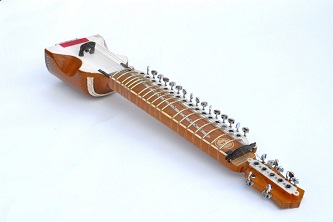
|
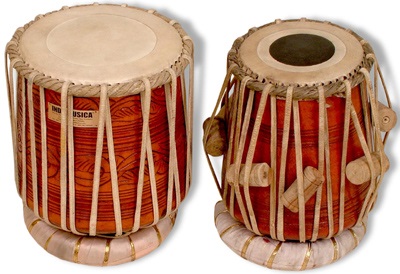
|
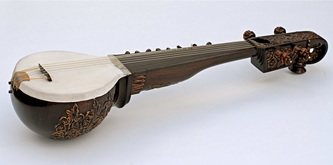
|
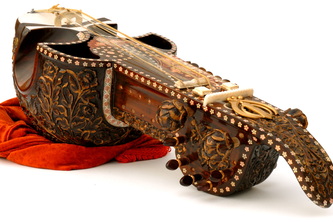
|
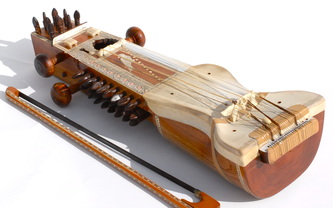
|
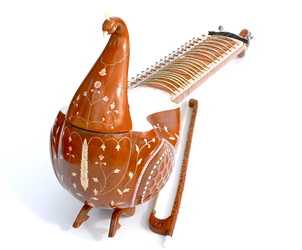
|
1. Aasa – Making effort;
2. Gujri – Satisfaction, softness of heart, sadness;
3. Dhanasari – Inspiration, motivation;
4. Sri Raag – Satisfaction and balance;
5. Maajh – Loss, beautification;
6. Gauri – Seriousness;
7. Devgandhari – No specific feeling but the Raag has a softness;
8. Bihaagra – Beautification;
9. Vadhans – Vairaag, loss (that is why Alahniya is sung in this Raag when someone passes away);
10. Sorath – Motivation;
11. Jaitsri – Softness, satisfaction, sadness;
12. Todi – This being a flexible Raag it is apt for communicating many feelings;
13. Bhairaagi – Sadness, (The Gurus have, however, used it for the message of Bhakti);
14. Tilang – Favourite Raag of muslims. It denotes feeling of beautification and yearning;
15. Soohi – Joy and separation;
16. Bilaaval – Happiness;
17. Gond – Strangeness, surprise, beauty;
18. Raamkali – Calmness;
19. Nat Narayan – Happiness;
20. Maali Gaura – Happiness;
21. Maaru – Giving up of cowardice;
22. Tukhari – Beautification;
23. Kedara – Love and beautification;
24. Bhairao – Seriousness, brings stability of mind;
25. Basant – Happiness;
26. Sarang – Sadness;
27. Malaar – Separation;
28. Kaanrha – Bhakti and seriousness.
29. Kaliaan – Bhakti Ras;
30. Parbhati – Bhakti and seriousness;
31. Jaijavanti – Viraag or loss;
In addition to raag names, there exists an indication in the titles of hymns called ghar. The precise meaning of ghar is not fully understood, although recent research proposes it refers to raag variants.
The Sacred Strings Of The Sikhs
The stringed instruments of the Sikhs are slowly returning to their rightful place in Guru's court, as more people take up learning Gurmat Sangeet and 'tanti saaj'. But what is all the fuss about?
If Sikhs can learn kirtan on a harmonium, why go through all that effort to learn an ancient instrument and spending years trying to master it?
The harmonium is simple, easy to pack and carry around, and most of all, easy to learn. Its creator, Alexandre Debain, never imagined that an entire race would use it as their main instrument for expressing their love for God. The harmonium has become an institution in the homes of all those who want Sikhism to grow fruitfully in their lives and within their family. And it has allowed millions of people to sing and express Gurbani without much difficulty.
The harmonium has become the defining feature of Sikh kirtan in the modern age, heralding from the early 20th century. Gurdwaras worldwide hire two harmonium players and an accompanying percussionist to sing hymns from the Holy Guru Granth Sahib with ease and precision. Their benefit is speed. There is no prior tuning involved, nor do their instruments require warming up or any intensive treatment. Harmonium players can just sit on stage and start singing before the sangat begin to rustle around and get bored.
Tanti Saaj
Listeners of the 'tanti saaj' are slightly different. They sit calmly and listen while the raagis tune their instruments and align their instruments in unison with each other's and to the tanpura's constant drone; each sympathetic string one by one until they hear sheer melody from the resonating strings.
The sangat joins in by tuning their own minds to the drone and blocking out all other sounds and senses, feeling at one with the Timeless Lord. They watch the raagis lovingly apply resin to their bows and prepare their fingers for the next hour of blissful sounds of Gurmat Sangeet, with an application of powder or oil, which makes their fingers glide across the strings.
Then the listeners prepare their ears for the instrumental shaan; the instruments salute their Guru and introduce the raag and flavour of the kirtan. The sangat are woken from their dreamy haze by the booming jori pounding its chest; the dilruba, stealing the sangat's heart with its sweetness; the hundred colours of the sarangi that brings with it the ancient stories of India; the graceful sounds of the peacock emulating from the glorious taus; the humble melody of Guru Arjan's saranda; and the gentleness of Bhai Mardana's rabab, that so humbly accompanied the father of the Sikhs, Guru Nanak, on his journeys to spread the truth.
With this mesmerising array of sounds and stories to share, it is difficult to believe that the Gurus' companions are today forgotten relics, replaced by a German organ.
We Forget Our Duty
This neglect is a result of our own actions. As our lives become faster and busier, speed has taken control of our day. We make no time for praying; no time for meditating on the truth; we struggle to sit cross-legged on the Gurdwara floor because we are too used to our desk jobs and swivel chairs; we fail to appreciate Mother Nature for her glorious theatrical displays, but curse her for delaying our trains; we forget our duties as human beings whilst busy earning a dollar to feed our families.
We lose ourselves. So, we need quick fixes of prayer, meditation, kirtan and inspiration. We need something that will fit into our 9-5 lives and not keep us too long from our worldly duties; hence the harmonium. It allows us to learn quickly and produce shabads without too much hard work.
Harmonium classes across the world mass-produce kirtanis and shabads like furniture in Ikea. Just pick what shabad you like from the shelf and you can put it together yourself. They are simple and easy to manage, and hey, they are trendy!
What Is Kirtan About?
But is this what kirtan is about? Why are Sikhs impatient and pre-occupied? We are born from generations of leaders yet we cannot devote time to our amazing heritage, we cannot invest in the future of our children, or give them the strength of the forefathers and martyrs from our past. These saints are commonly referred to as the people from 'that time back then' and we immediately segregate ourselves from Sikhi's diamonds.
But the strength of those masters came from their lifestyles and choices. And we can choose to live a saintly life also. By choosing a path of speed and ease, we open our lives to impatience and ignorance. But we can decide to take control of our lives by opting to live in the same light of our Gurus, by making the right choices, and being awake to hear what is going on.
Gurmat Sangeet
Gurmat Sangeet is one way to live a saintly life. By choosing to pick up the Gurus' instruments, you choose to live a life of Sehaj, where you will continue learning your entire life and surrender to the Guru's hukam.
As you learn how to care for your instrument you will gain respect for your Guru and the Sadh Sangat. When hearing the sacred sounds of the blessed instruments and reciprocating them, you will learn to understand the musicology of your neighbors' and how to reply to their emotions.
While balancing your bow and controlling your rhythm, you will learn to love and respect Mother Earth and will walk in harmony with her heartbeat. As you sing the Guru's own words, you will want to speak only sweetness and goodness with your blessed tongue. You will be overcome with empathy and will care for those less fortunate than yourself, nourishing their minds, bodies and souls with your own hands and hard work. You will gain the attributes of a Sikh and will radiate Vaheguroo to all you meet.
To be able to hold one of the instruments that the Gurus carried is such a privilege. Gurmat Sangeet is not about learning as many shabads as you can; it is about daily practice, discipline and living a life of Kirtan, where you learn how to learn, and how to understand Gurbani. Its about following the Guru's order, through music and Gurbani, and trying to live life in the Guru's light. Gurmat Sangeet is more than just a way to sing and play music; Gurmat Sangeet is a way to live.



